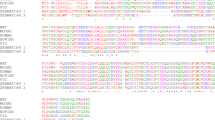Abstract
We report herein the presence of a 56 kd platelet derived growth factor (PDGF)-related protein as a phosphorylated form in human glioma cells. The phosphorylation of the 56 kd form was found to be the longest of all PDGF-related proteins. By Western blotting using a monoclonal anti-PDGF B-chain, the 80 kd, 56 kd, 40 kd, 28 kd and 17 kd PDGF-related proteins were detected, while after treatment among the nitrocellulose membrane transblotted cell extracts with alkaline phosphatase, 40 kd was the most densely observed while the 56 kd and 80 kd PDGF-related proteins were also detected. In a 32P flush labeling study, it was revealed that PDGF-related proteins incorporated with 32P were detected at 28, 32, 35, 40, 56 and 80 kd but the 17 kd monomer was not labeled. Among the labeled PDGF-related proteins, the 56 kd PDGF-related protein alone remained intracellularly for at least 16 hours. These results indicated that the PDGF-related proteins in human glioma cells are synthesized in a phosphorylated form and partly remain in a 56 kd phosphorylated form intracellularly. The 56 kd form may thus be the most stable form and likely has a substantial biological effect.
Similar content being viewed by others
References
Pardee AB: G1 events and regulation of cell proliferation. Science 246: 603–608, 1989
Hermansson M, Nister M, Betsholtz C, Heldin C-H, Westermark B, Funa K: Endothelial cell hyperplasia in human glioblastoma: coexpression of mRNA for platelet-derived growth factor (PDGF) B chain and PDGF receptor suggests autocrine growth stimulation. Proc Natl Acad Sci USA 85: 7748–7752, 1988
Heldin C-H, Betsholtz C, Johnsson A, Westermark B: Role of PDGF-like growth factors in malignant transformation. Cancer Rev 2: 34–47, 1986
Johnsson A, Heldin C-H, Westermark B, Wasteson A: Platelet-derived growth factor: identification of constituent polypeptide chains. Biochem Biophys Res Commun 104: 66–74,1982
Antoniades HN, Scher CD, Stiles CD: Purification of human platelet-derived growth factor. Proc Natl Acad Sci USA 76: 1809–1813, 1979
Heldin C-H, Westermark B, Wasteson A: Platelet-derived growth factor: purification and partial characterization. Proc Natl Acad Sci USA 76: 3722–3726, 1979
Nister M, Heldin C-H, Wasteson A, Westermark B: A platelet-derived growth factor analog produced by a human clonal glioma cell line. Ann N Y Acad Sci 397: 25–33, 1982
Hammacher A, Mellstrom K, Heldin C-H, Westermark B: Isoform-specific induction of actin reorganization by platelet-derived growth factor suggests that the functionally active receptor is a dimer. EMBO J 8: 2489–2495, 1989
Niman HL, Houghten RA, Bowen-Pope DF: Detection of high molecular weight forms of platelet-derived growth factor by sequence-specific antisera. Science 226: 701–703, 1984
Raines EW, Ross R: Platelet-derived growth factor, 1. High yield purification and evidence for multiple forms. J Biol Chem 257: 5154–5160, 1982
Nakamura T, Takeshita I, Fukui M: Glioma-derived PDGF-related protein present as 17 kd intracellularly and assembled form induces actin reorganization. J Neuro-oncol 11: 215–224, 1991
Hart CE, Seifert RA, Ross R, Bowen-Pope DF: Synthesis, phosphorylation, and degradation of multiple forms of the platelet-derived growth factor receptor studied using a monoclonal antibody. J Biol Chem 262: 10780–10785, 1987
Ponten J, Westermark B: Properties of human malignant glioma cells in vitro. Med Biol 56: 184–193, 1978
Towbin H, Staehelin T, Gordon J: Electrophoretic transfer of proteins from polyacrylamide gels to nitrocellulose sheet: procedures and some applications. Proc Natl Acad Sci USA 76: 4350–4354, 1979
Ross R, Masuda J, Raines EW, Gown AM, Katsuda S, Sasahara M, Malden LT, Masuko H, Sato H: Localization of PDGF-B protein in macrophages in all phases of atherogenesis. Science 248: 1009–1012, 1990
Shiraishi T, Morimoto S, Itch K, Sato H, Sugihara K, Onishi T, Ogihara T: Radioimmunoassay of human platelet-derived growth factor using monoclonal antibody toward a synthetic 73–97 fragment of its B-chain. Clin Chim Acta 184: 65–74, 1989
Sternberger LA, Sternberger NH: Monoclonal antibodies distinguish phosphorylated and nonphosphorylated neurofilaments in situ. Proc Natl Acad Sci USA 80: 6126–6130, 1983
Robbins KC, Antoniades HN, Devare SG, Hunkapiller MW, Aaronson SA: Structural and immunological similarities between simian sarcoma virus gene product(s) and human platelet-derived growth factor. Nature 305: 605–608, 1983
Author information
Authors and Affiliations
Rights and permissions
About this article
Cite this article
Nakamura, T., Takeshita, I., Inamura, T. et al. The 56 kd platelet-derived growth factor (PDGF)-related protein is phosphorylated and the most stable form in human glioma cells. J Neuro-Oncol 13, 105–109 (1992). https://doi.org/10.1007/BF00172759
Issue Date:
DOI: https://doi.org/10.1007/BF00172759




